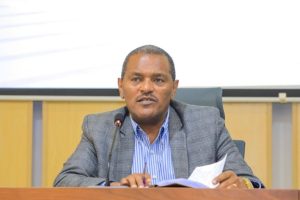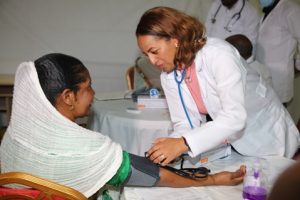
On July 2015, The Ethiopian government launched the Seqota Declaration, a covenant to eliminate stunting on children less than two years of age by 2030 from Ethiopia. In addition, to achieve its goal, the declaration focuses to change the livelihood of every household socially and economically. The name Seqota was given to the Declaration as government pledged to prioritize the Seqota area, mainly targeting the Tekeze River Basin area which included parts of Amhara and Tigray states which highly affected by drought for several years especially during 1984/5. Still the area is not free from that legacy of drought.
Due to the recurrent droughts and other reasons, badly this area remains backward in infrastructural expansion both in quantity and in quality. Related to that maternal and child nutrition problem is high and the level of stunting on children in the area is top in the country.
According to Ministry of Health in Seqota area, the rate of stunting on children under two years is up to 50 percent and on those between two and five years is up to 60 percent while the average of the country’s stunting is 38 and 50 percents respectively. Considering this in mind the Ethiopian government has launched the covenant and started implanting the program in 33 woredas of Tekeze River Basin of Seqota area, 27 woredas in Amhara and six in Tigray states as initial phase of the program, according to Program Manager. The program has three phases, the innovation, expansion and scale up.
The innovation phase is planned to implement on these 33 woredas of the Tekeze River Basin and to expand the practical experience to the national level and then to scale up the activities to eliminate stunting from the country by the end of the program, in 2030. Mulugeta Yimam, Ebinat Woreda Administrator, a local administration in North East Gondar of Amhara state said that many people are living under poverty level to meet the minimum acceptance diet for their children and early marriage is largely practicing in the society. According to him the woreda has 31 kebeles with over 204 thousand dwellers.
According to him as the area remains backward in all facilities, it is hard to fulfill food security. He added that the people of the society have a hope that the SD may bring new change to eradicate and eliminate the problem of food shortage by solving the basic social, infrastructural and economic problems of the area. With this hope, his woreda administration is starting implementing the programs of the declaration combining with every sector offices’ annual plan with due efforts. He noted that the woreda has targeting improving agriculture, health service facility, educational service and water provisions mainly.
To improve and expand these services, community lab is established in Gelamatebya kebele, one of the 31 kebeles’ of the Woreda administration. Although the administration is escalating its efforts to implement the packages of the program, still it faces shortage of inputs in material, improved crops and fruit seeds, shortage of finance and limitations of awareness on the society which needed further mobilization and sensitization. According to him, parallel with the practical implementation of the program on the ground, the administration is focusing on attitudinal change of the society to combat early marriage, to aware 1000 days movement and other sensitizations to the society.
Dawit Gebreegziabiher, Naeder Adiet Woreda Administrator, a local administration found in Central Zone of Tigray state also noted that the woreda has 23 kebeles with over 150,000 dwellers. According to Dawit, the SD has targeted all the dwellers of the woreda and one community lab center is established in Adisalem Kebele of the woreda aiming at expanding the lab to other kebeles after making it model community lab to make center of learning to the community.
His woreda administration is also starting practicing the main programs of the declaration although a lot remains due to financial and input shortages. Both administrators said that technique and steering committees are established in their woreda’s to help the implementation of SD and community lab is started. Seqota Declaration (SD) Federal Delivery Unit Senior Program Manager, Dr. Sisay Sinamo told The Ethiopian Herald that immediately after the program was launched a 15-year roadmap was established with three phases. Dr. Sisay stated that the innovation phase of the program is planned to implement with 10 main tasks in fiveyear period and is now on its second year.
Health, agriculture, water & energy and irrigation, education, social security, women and children sectors are given the priority during this phase. Water investment, high tech farming, community lab on agriculture, 1000 days movement is the focus areas to improve the sectors. Although the innovation phase was practicing during the past two years, its performance was slow as evaluated in January 2019 by the government led by Deputy Prime Minister Demeke Mekonnen, Dr. Sisay noted.
He added that on that evaluation meeting government puts a direction to boost the implementations of the declaration. Following that meeting member of stakeholders from seven ministries and other sectors, including four ministers have held field visit on five woredas in Seqota area three weeks ago and observed the problems of the area and the implementation level of the declaration, Sisay noted. The group of travelers then evaluated the level of the innovation phase on the ground, identify the current basic problems of the society put two directions, the Program Manager stated.
Shortage of water provision, the income of the society is too low, the low productivity of agriculture in the area, facility and quality problem of health sector, absence of platform to start school feeding as tent school with wood is still found in the area, shortage of finance and the backward cooperation system in the lower administrations are identified as the main problems of the declaration. To solve these identified problems and to accelerate the implementation of SD, two action plans are preparing after the discussion, Dr. Sisay noted. The first plan is identify the critical problems which need immediate implementation before June 30. The three months plan is already prepared and need improvement by the stakeholders.
As to him the second action plan is to prepare additional two years plan aiming at facilitating the innovation phase in addition to the first plan of the program. According to Dr. Sisay, the performance of the program was slow mainly due to financial resource limitations after the innovation phase start implementation, the multispectral nature of the program. Now, government put actions to solve these problems with new commitment to meet the goal of the covenant.
In last week, Save the Children has granted 9.3 million Birr to support the implementation of SD of three woredas, Ebinat and Debarik of Amhara state and Naedier Adet of Tigray state. Dr. Sisay calls all development partners, donors and other stakeholders to further their support to fight stunting. As multisectoral cooperation and coordination is crucial and turning point to the program, he calls all sectors from federal to the lower structure to work cooperatively and jointly to eliminate stunning. It was learnt that after the practical implementation experience of Seqota area, after one and half year, the program will expand to the national level.
The Ethiopian Herald April 27/2019
BY DARGIE KAHSAY




